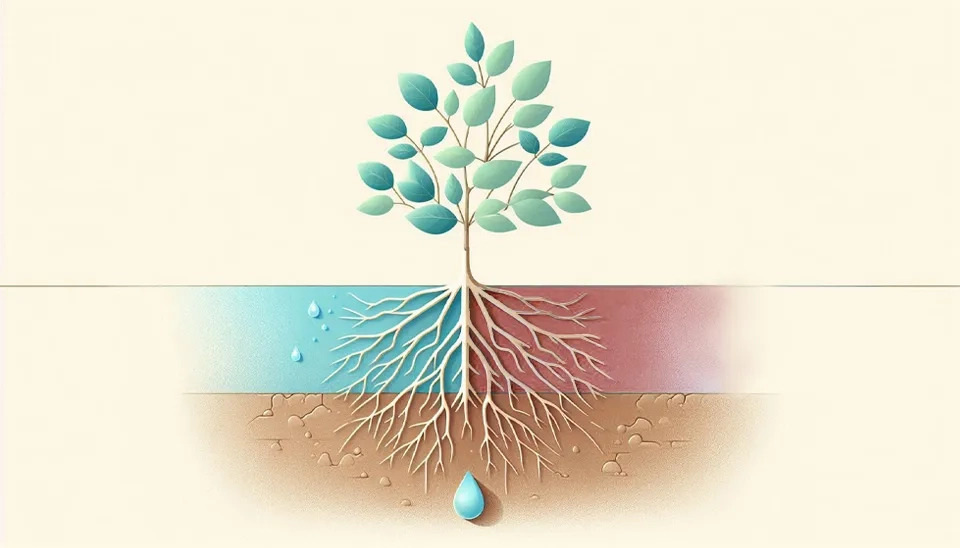
How much water do you think you can save using the innovative Partial Rootzone Drying (PRD) irrigation method while still maintaining or even improving your crop yield?
Agriculture in arid and semi-arid regions relies on irrigation to achieve satisfactory yields. One of the main environmental and social problems in these regions is freshwater shortage and One of the newest water-saving irrigation methods is partial root zone exposed alternately to soil drying. In the growing demand for sustainable agricultural management, partial rootzone drying (PRD) emerges as a revolutionary method of irrigation, merging water conservation with crop productivity (lima et al, 2015).
Unlike conventional irrigation methods, PRD exploits one important biological principle: the inherent capacity of the plant to adapt root activity with regard to water use and management of water stress. By improving how water is actually delivered to the crop, PRD offers solutions for two major contemporary agricultural issues related to water security and effective resource use.
One of the promising methods that has received considerable attention in the past years is the PRD technique. By alternation of wet and dry soil cycles in the root zone, PRD enhances the plant's inherent ability to alter water stress. Besides being water-saving, this technique stimulates root growth, increases nutrient uptake, and generally improves the performance of plants. PRD Irrigation Strategy offers a sustainable solution to the rising demand for food and fiber, particularly in regions that encounter water-critical concerns. By improving water delivery and decreasing water loss through evaporation and deep penetration, PRD can also help to diminish the impacts of climate change and enhance long-term food security (Intrigliolo et al., 2009).
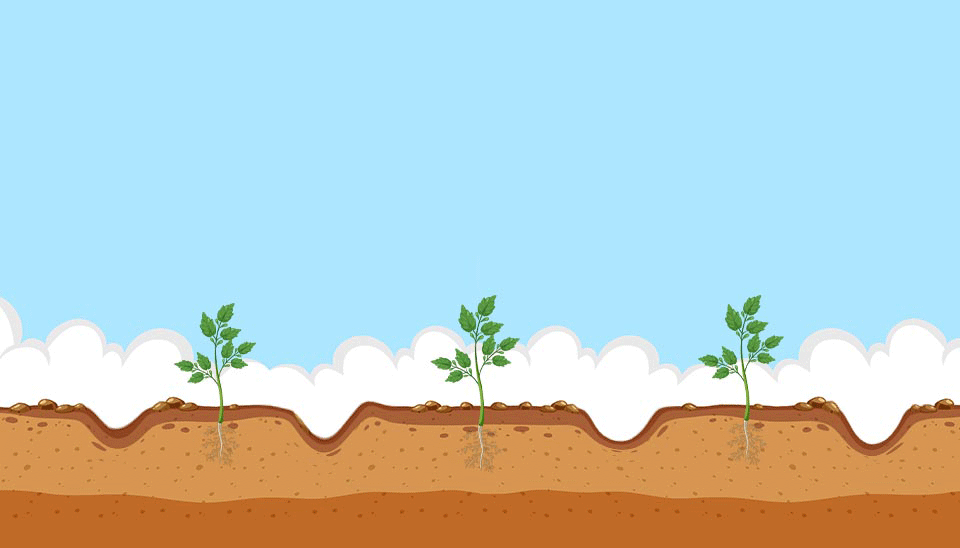
In this article, the mechanisms, benefits, and practical applications of Partial Rootzone Drying (PRD) are comprehensively reviewed. Furthermore, its potential impact on improving water use efficiency, crop productivity, and sustainability in various agro-climatic zones is discussed.
1. Mechanism of Partial Rootzone Drying (PRD)
In implementing the Partial Rootzone Drying Irrigation method, selectively irrigating only one part of the root zone while plants are leaving dry on the other side. This control alternation between wet and dry roots simulates the plant’s ability to sense soil moisture amount and adopt its growth and water-use decisions accordingly.
By irrigating only one side of the root, PRD induces the plant to concentrate its roots in the moist area, developing its roots deeper in search of more water. Traditionally, there is a division of the root zone into two parts: one remains irrigated while the other side is dried out, particularly. The plant is then constantly changed to each zone of the root system by shifting irrigation between these two areas. This process is repeated in periods , often every few days, ensuring that the plant alternates between experiencing dry conditions on one part of the root zone and receiving sufficient water on the other side (Intrigliolo et al., 2009).
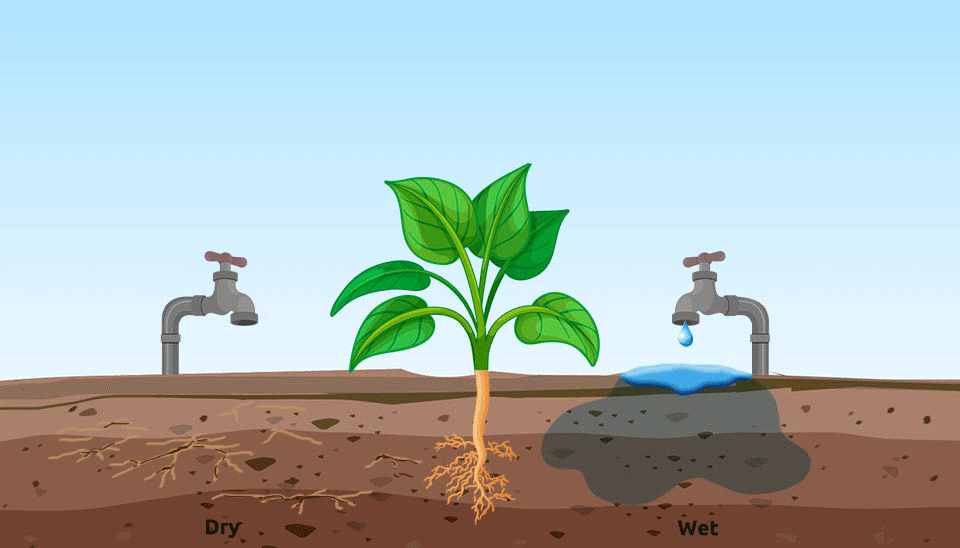
The idea of PRD Water Management revolves around inducing controlled water stress on crops, which provokes a series of adaptive mechanisms that grow water use efficiency. When the dry part of the root zone is exposed to a water deficit, the plant perceives this as drought stress and begins to activate several protective measures.
The production of plant hormones, such as abscisic acid, is one of the main reactions. This causes the plant to decrease transpiration, which is a water-saving mechanism. While this is occurring, the plant is also capable of altering its root architecture, forming roots that are deeper and more abundant in its search for water. The plant particularly adapts by optimizing its water usage, making certain survival even in challenging conditions. ( Yingying Ma et al, 2024)
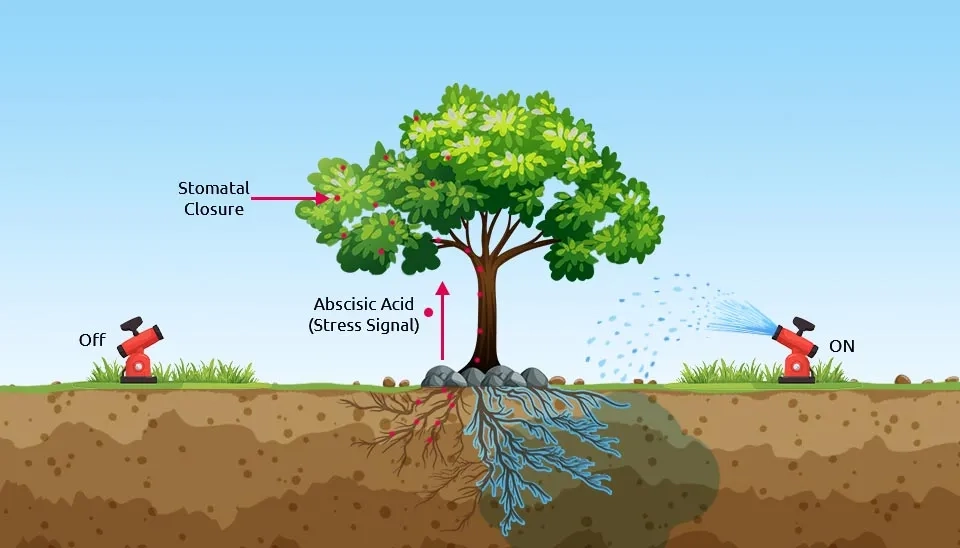
On the irrigation side, the roots persist in obtaining water. Conserving the plant’s physiological needs. These changing wet-dry conditions simulate the natural conditions faced by plants, often by changes in water availability due to erratic rainfall. Cycling would thus simulate the patterns of natural drought, enabling the plants to be more capable of coping with water stress and increasing their overall flexibility toward changes in the environment. Typically, the irrigated and drying sides of the root zone alternate regularly. Soil drying and rewetting cycles during the partial root zone drying approach stimulated root growth and improved soil nutrient availability and plant nutrient uptake. (Pérez-Pérez et al, 2020)
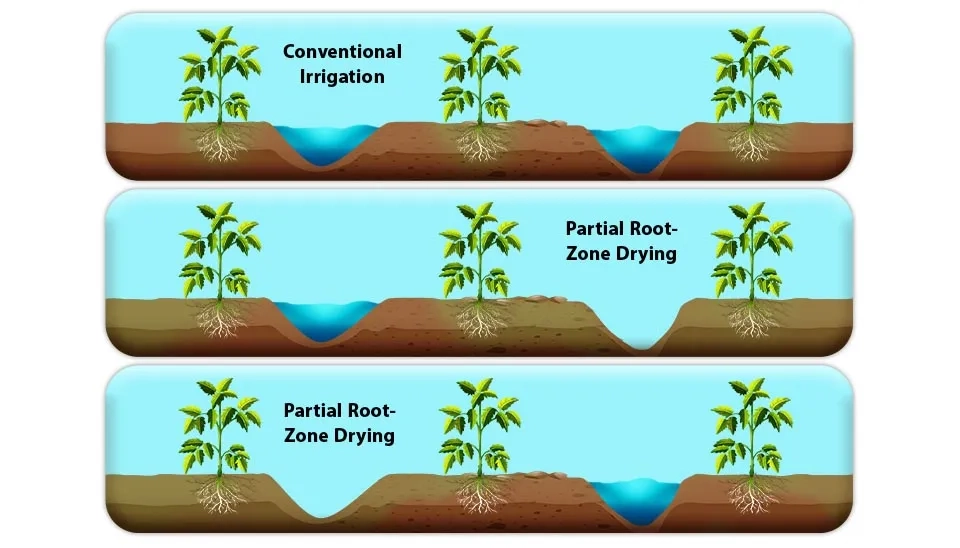
PRD strategy is a methodology that involves the creation of alternate wet and dried areas within the area of the rooting zone. Since the alterations can be used with different modes of irrigation techniques, it offers an opportunity or a chance to use, for example, drip irrigation or subsurface drip irrigation. The drying phase enhances soil aeration, reducing the possibility of waterlogging and root diseases. The drying-wetting cycle helps to bring out salts from the root zone, decreasing soil salinity. The intermittent stress caused by drying can motivate root growth considerably in the deeper soil layers. Plants can access water from a larger volume of soil by this deeper root system. PRD is a good method for branching, which improves the uptake of water and nutrients in addition to increasing root density. (Kusakabe et al., 2016). The drying-wetting cycle may improve nutrient intake by plants. This is because during the drying phase, nutrients within the soil solution can become more concentrated, hence increasing their availability to the roots. This will reduce the demand for plants for nutrient applications. The drying-wetting cycles can encourage the growth of beneficial soil microorganisms. These microorganisms can enhance nutrient uptake, improve soil structure, and defeat plant diseases (Intrigliolo et al., 2009).
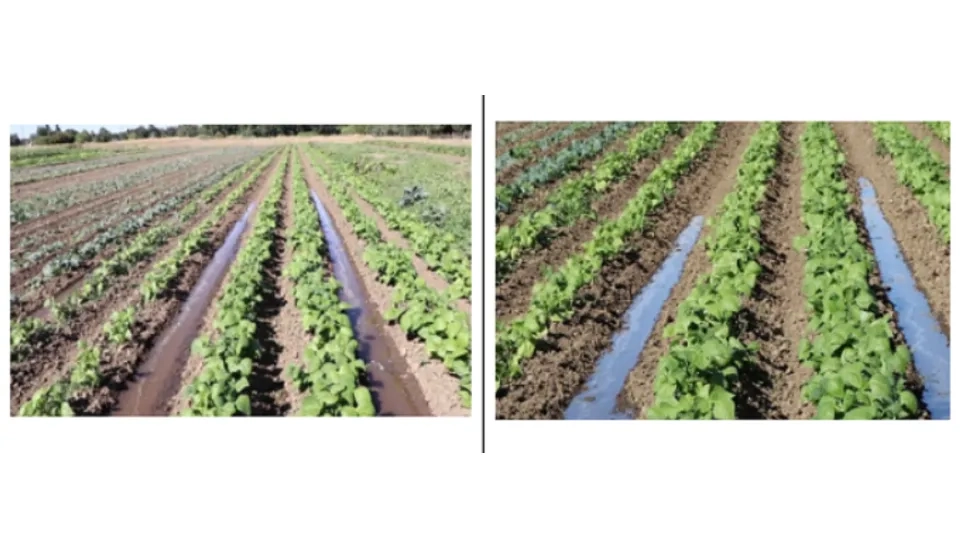
2. Benefits of PRD Over Conventional Irrigation Methods
Pérez-Pérez et al, 2020 , investigate the interaction between abscisic acid (ABA) and aminocyclopropane carboxylic acid (ACC) in controlling stomatal responses to soil drying and re-watering. Both ABA and ACC assemble in roots in reaction to soil drying, but neither collects in xylem or leaves. When re-watering happens, the entire rootzone brings back stomatal conductance; however, re-watering only the side of the rootzone further diminishes it. The circle of re-watering the dry part of the pot growth xylem and leaf ACC concentrations and leaf ethylene evolution. PRD irrigation methods have a significant effect on enhancing water use efficiency (WUE) by regulating stomatal treatment, tree water status, and leaf growth. By using this technique, partial stomatal set while preserving CO₂ assimilation, fruit yield, and canpoy development.
Yingying et al., 2024, investigated the effect of various irrigation regimes in cotton plants on ABA and other hormones in regulating stomatal. Partial rootzone drying (PRD) induced stomatal closure correlated with improving foliar ABA levels, while deficit irrigation (DI) led to stomatal closure linked with raised levels of multiple hormones, including ABA, SA, IAA and cis-OPDA. Interestingly, extended soil between hormonal and hydraulic signals. The results show the delicate value of both irrigation volume and placement in the potential involvement of different hormonal factors beyond ABA and eventually determining stomatal responses.
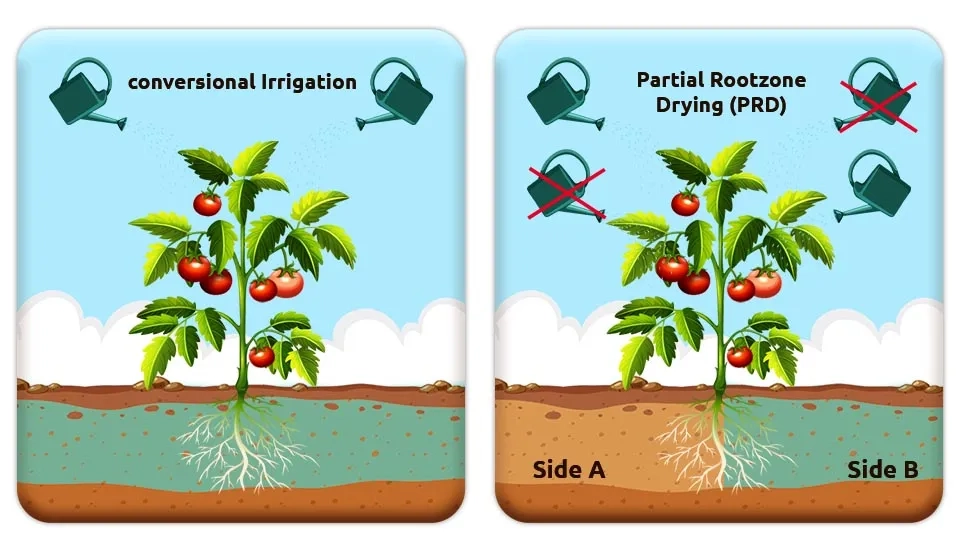
PRD irrigation methods can affect stomatal conductance and vegetative growth by diminishing them without any bad effect on yield or fruit quality. However, differentiation between two irrigation methods, PRD and conventional deficit irrigation, shows higher yields and better fruit quality with PRD, particularly in situations of sandy soil farms. Considering high potential benefits of the Rootzone Partial Drying Method, such as better light exposure and improved fruit composition, shows research is necessary in this type, especially in various soil types and climatic conditions. (Yingying Ma et al, 2024)
Using the PRD method through drip irrigation significantly reduced water consumption compared to conventional micro-sprinkler irrigation methods. PRD-irrigated citrus trees have better Water Use Efficiency (WUE) compared to micro-sprinkler-irrigated trees and PRD conserved yield levels comparable to control trees, although micro-sprinkler-irrigated trees had better yield. Fruit quality and juice characteristics keep stable, although PRD shows diminished fruit drop in the second season after applying the PRD method. According to this research, the effectiveness of PRD was most noticeable during dry summers with minimum rainfall conditions. These detections show drip PRD could be a viable strategy for many plants, such as citrus growers, to enhance water use, preserve tree health, and sustain yields, especially in regions with water scarcity or stringent water restrictions. (Kusakabe et al., 2016)
Application of the PRD method can be beneficial in controlled environments, although in fields with heavy-textured soils and Mediterranean climates, if you want to apply this method, you should pay consideration. Some parameters can restrain the potential for enhanced water use efficiency, like soil type, climate, and irrigation system design (Intrigliolo et al., 2009).
3. Applications of PRD in Different Agro-Climatic Zones
Some studies assess the impact of different irrigation strategies in plants; one of them is Lima et al.'s (2015) research, which assesses the impact of diverse irrigation strategies on papaya trees. The irrigation methods were partial root drying (PRD), regulated deficit irrigation (RDI), and no irrigation followed by rehydration (NI-gh). In experiments done in greenhouses, PRD and RDI reduced shoot and root dry weight production considerably compared to full irrigation (FI) at lower water use levels. According to results, applying a 30% water deficit in both PRD and RDI treatments did not remarkably affect vegetative growth or yield portion. Although PRD had an effect in the greenhouse experiments by closing non-hydraulic stomata, this effect was not suitable in field conditions for enhancing yields. Another result was that both irrigation methods, PRD and RDI, enhanced water use efficiency (WUE) compared to full irrigation, showing that papaya plants can stand amounts of water deficits without any significant effect on their yield. Eventually, the study suggests that applying deficit irrigation can be used in planting papaya, although PRD does not show any more advantages over RDI in terms of yield or water use efficiency.
In the other study, Intrigliolo et al. (2009) assessed the effect of the partial root zone drying (PRD) irrigation method on some factors of grapevine, like yields and fruit quality, compared to conventional drip irrigation. Despite expectations, PRD did not noticeably affect vine growth, fruit composition, or wine quality. Because of the clear lack of soil drying and wetting cycles between two sides of the vine, it might have restricted the effectiveness of this irrigation method (PRD). While Rootzone Partial Drying (PRD) can be beneficial in controlled pot experiments, its implementation in field conditions, especially considering soil type, environmental conditions, and irrigation system when applying PRD, also focuses attention on the need for further research on the interaction between irrigation, crop level, and wine quality.
The impact of two water-saving irrigation strategies, partial rootzone drying (PRD) and Deficit Irrigation (DI), on the quality of tomato fruits had been assessed in the University of Copenhagen, Taastrup, Denmark. Both techniques aim to diminish water consumption while preserving crop productivity. The results indicated that both PRD and DI had no noticeable effect on tomato yield. However, PRD is verified to be superior to DI in terms of fruit quality; fruits from PRD-treated plants reveal significantly higher concentrations of essential minerals (calcium and magnesium), organic acid (citric and malic acid), sugar (glucose and fructose) and other nutrients ( phosphorus and potassium). These studies suggest that PRD is a more effective water-saving strategy than DI for improving tomato fruit quality. By particularly drying and wetting different sides of the root zone, PRD causes physiological responses in plants that can improve nutrient uptake, enhance fruit development, and ultimately lead to higher-quality fruits. Consequently, for sustainable agriculture, PRD could be a valuable method in tomato production, especially if you have limited water resources available. According to these results, extra research is needed to assess the underlying mechanisms of PRD and to gain optimum productivity in various (Sun et al., 2014).
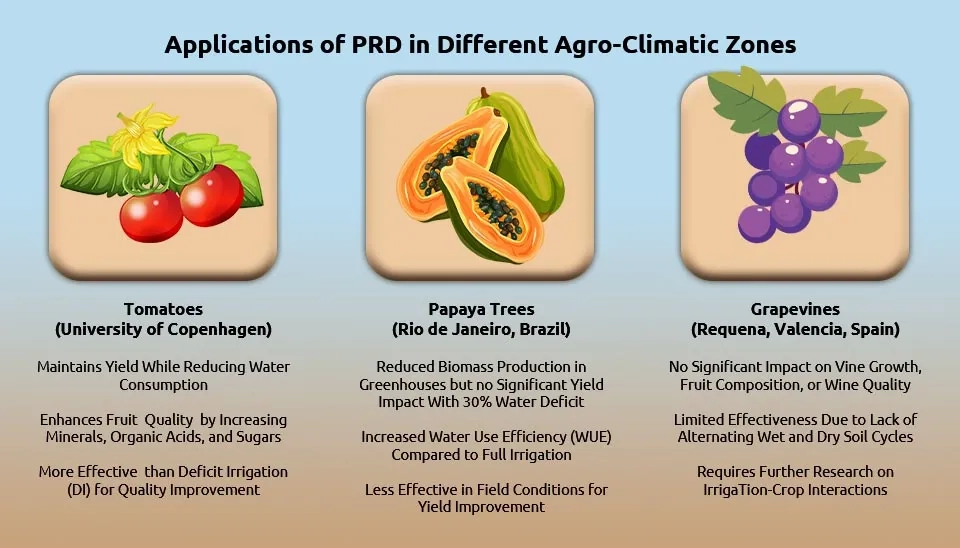
According to a study at the Texas A&M University-Kingsville Citrus Centre, partial rootzone drying (PRD) irrigation noticeably improved water use efficiency (WUE) in citrus trees compared to other conventional irrigation methods. In this research, they compared drip PRD, microsprinkler irrigation, and double-line drip irrigation in a mature grapefruit orchid over two seasons. According to the results of implementation, the PRD irrigation method reduced 43–47% of water use, while microsprinkler irrigation reduced only 12–18% of water consumption. PRD irrigation conserved or increased yield while diminishing water use and triggered a higher WUE than other kinds of irrigation treatments, and on the other hand, PRD did not have a negative impact on flowering or vegetative growth. Results show we can use PRD as a promising technique for sustainable citrus planting, particularly in regions with water scarcity or restrictions (Kusakabe et al., 2016).
According to a study in South Australia, in a region with restrictions on water resources, several factors have been assessed on tomato plants. Using recycled wastewater and fresh water in two different irrigation methods, including ordinary and partial root zone drying (PRD), shows that PRD lowered soil phosphorus , potassium and magnesium concentration compared to ordinary irrigation, indicating that in this irrigation method the absorption of fertilizer from plants is more. The results also show that water quality influences canopy coverage and it is clear that PRD is a suitable method for sustaining agriculture in regions with water shortages, and it can improve water use efficiency (Alrajhi et al, 2017).
4. Conclusion
We can use partial rootzone drying (PRD) as an innovative irrigation method that provides noticeable advantages in growth water use efficiency (WUE) and crop productivity. In this irrigation method, by selectively drying a portion of the root zone, PRD triggers physiological responses in plants and finally leads to reduced water loss and improved nutrient uptake. Key advantages of the PRD irrigation method:
1. Enhanced water use efficiency (WUE): Applying innovative irrigation methods such as PRD can diminish water use by inducing stomatal closure and restricting transpiration of plants. PRD technique can affect consuming water by promoting deeper root growth and enhancing nutrient uptake.
2. Improved soil health: Applying PRD changes wet and dry cycles and eventually enhances soil structure and microbial activity. On the other hand, according to several studies, PRD can diminish soil salinity and nutrient leaching.
3. Improve crop productivity: According to several studies in different climates and plants, PRD triggered increased yields and improved fruit quality. On the other hand, PRD techniques help to conserve plant growth and development considerably in water shortages and regions with limited access to water resources.
4. Enhanced stress tolerance: We can look to PRD technique as a good solution for enhancing plant tolerance to various stresses such as drought, heat, and salinity. Also, it should be considered that the effectiveness of PRD depends on many different factors like soil type, climate, crop species, and irrigation system design, and it is necessary to carefully consider these parameters and their effect on plants when applying the PRD method.
Finally, PRD has excellent results in most studies, although further research is needed for understanding the mechanisms and enhancing productivity and water use efficiently in this method. If you consider the special needs of the plants and the environment it would be planted in, PRD could be a helpful irrigation method in sustainable agriculture and also water conservation.